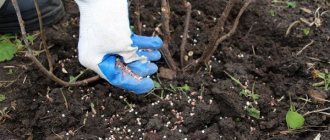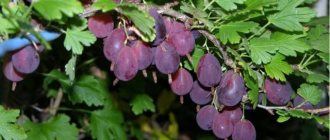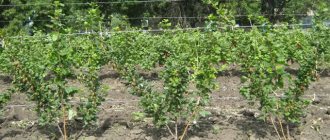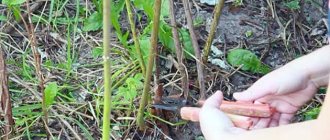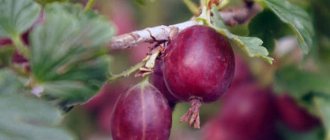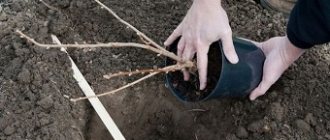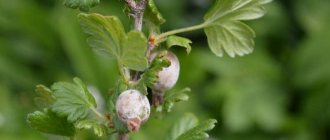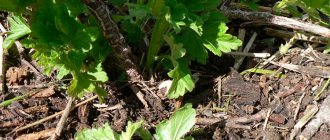In our country, many gardeners plant gooseberries on their plots. This culture is unpretentious in care and grows in almost all climatic zones, without creating any particular difficulties.
One of the most significant problems of gooseberries is a large (sometimes too large) number of shoots. If gooseberry pruning is not carried out or done irregularly, after a few years harvesting will be almost impossible, since the branches of the crop are very thorny, and the needles will simply interfere with successfully reaching the berries. In addition, the abundance of shoots will affect the yield in the direction of its reduction. The plant loves light, and in order to get a good harvest, the fruits require excellent lighting. Considering the above, pruning gooseberries in the spring is a procedure that is not recommended to be neglected.
When to prune gooseberries in spring
It is most effective to prune gooseberries in early spring, when the growing season of the plant has not yet begun. If you carry out the procedure in early March, when the branches are still “sleeping,” normal growth will be ensured for the gooseberries. Since sap flow begins almost with the first warm rays of the sun, it is quite difficult to guess the time. Especially if the gardener does not live on his plot permanently, but visits it from time to time. Under no circumstances should pruning be carried out if the growing season has already begun and the buds have begun to swell. It will be more advisable to wait until the fall for the procedure. Otherwise, the bush will be damaged, and you can only dream of a decent harvest.
We recommend reading these articles:
Pruning cherry plum in spring for beginners in pictures step by step
Pruning peach in spring for beginners in pictures step by step
How to grow spinach on a windowsill in an apartment in winter
Important! Gooseberries are a crop that is one of the first to awaken after winter. In this regard, you need to prune the plant as soon as the snow melts and the ground dries out a little.
Thus, depending on the climate of the region, the approximate timing of spring pruning of currants is March-April (early May).
In the southern regions - at the end of March-beginning of April.
In the middle zone (Moscow region) - in the second half of April.
In the Urals and Siberia - in early May. Around the same time, you can start pruning in the North-West (in the Leningrad region).
Gooseberry trellis formation
Once upon a time, the fashion for trellises was very high. Scientists have proven that the fruits from plants growing on a trellis are more tasty, larger and contain more useful substances, however, the costs of installing a trellis are very high, both financial and physical, and the trellis has become a kind of experiment that is not everyone decides to hold it in their own area.
Where to start? Of course, from planting gooseberry bushes. For a full-fledged trellis you need at least five to six bushes, possibly of different varieties, planted very close to each other (about half a meter). After the bushes are planted, we build a trellis - we dig a post along the edge of the row and stretch three rows of wire between them at a height of 40 centimeters from the ground, 70 centimeters from the ground and a meter from the ground, this is quite enough. Next, as the gooseberry shoots grow, we tie them to the trellis using twine, placing them so that the branches are approximately 18-20 cm apart from each other.
Subtleties: it is better to place the trellis with its flat side facing east, so that the sun illuminates it as much as possible before noon and after, and in the hottest time it shines on the side of the trellis, otherwise the bushes may get burned.
Try to leave and tie to the trellis no more than six strong, powerful shoots belonging to one gooseberry bush; the rest can be safely cut out at the base of the soil. During the growth process, last year's shoots must be shortened by approximately 45-50%, and no more than six shoots should be left from the current year's growth to prevent excessive thickening. After five years, you can rejuvenate the gooseberry bushes by leaving three or four young shoots on each plant, and cutting out the rest at the base of the soil.
What other advantages does a trellis have besides those previously listed? Of course, the convenience of picking fruits; As you know, gooseberries are a thorny crop, so picking fruits from a bush is difficult, but from a trellis - in fact, a green wall - it is much more convenient. The berries always remain clean and are much larger.
Gooseberry bushes formed on a trellis
Preparation for pruning: tools
As you know, gooseberries are a very thorny shrub, which means that if you don’t want to prick your hands while pruning, you need to wear fairly thick gloves (optimally welder’s gloves).
And of course, you will need a well-sharpened pruner (the most ordinary one).
By the way! It is very convenient to trim gooseberries with long-handled pruners (loppers): with its help it is much easier to penetrate into the center of the bush. In addition, in this case you can do without protective gloves.
However, pruning young branches is not very convenient for them...
We follow the rules of procedure
When pruning, follow a few simple rules:
- they work with a sharply sharpened tool - this way the shoot is not severely damaged and there are fewer ways for pathogens and pests to penetrate;
- work is carried out in protective clothing and thick gloves;
- the instrument is disinfected from pathogenic microflora;
- First, cut off the outer contour, then the internal branches;
- cut areas are disinfected and protected with garden varnish.
See also Growing gooseberries in open ground: rules for planting and care
After pruning, the gooseberries are watered with clean water. Fertilizers are applied when the wounds on the shoots heal.
Why do you need to prune gooseberries in spring?
Many amateur gardeners do not know and do not understand what pruning gooseberries is, when and how to do it correctly. Let's figure it out in order
Important!
Gooseberries need not only pruning, which can be done 12 months after planting, but also fertilizing, careful watering and bush formation.
Pruning should be done correctly by dividing it into the following stages:
- Formative. This stage is carried out immediately after the bush has rooted. It needs to be given the appropriate shape so that it does not interfere with nearby plants and can develop unhindered.
- Wellness. It is carried out to remove dried and disease-prone branches, as well as to get rid of insect pests (aphids, spider mites). All unsuitable parts of the bush that interfere with the development are removed.
- Stimulating. The point of this pruning is to “give new life” to the gooseberry, so that it can grow and produce new young shoots.
Step-by-step pruning schemes in the photo are indicated accordingly. The benefits of such a procedure are simply colossal; pruning will prevent:
· weakness of the bush;
· low percentage of yield;
· reduction of berry shapes and sizes;
· development of infectious plant diseases and reproduction of insect pests;
· lack of sunlight, removing excess shade from the area;
· inconvenient approach to the bush for picking berries;
· tightness of branches, which may result in a lack of oxygen for the plant;
· premature aging of berry crops.
It is important to carry it out in a timely manner; the results of your own efforts can be seen after a short period. Under no circumstances should you let the bush grow, otherwise it will easily turn into a “wild thing”, and instead of berries you will only see prickly thorns.
Where to begin?
The very first pruning should be carried out immediately after planting the gooseberries on the site. Of course, when planting in the fall, it is better to wait until spring, but when planting in the spring, there is no point in putting off pruning. The shoots of a newly planted gooseberry seedling must be shortened in such a way that only a part with four or five buds remains from each shoot, no more. There is no need to be afraid, the gooseberry bushes will only look unsightly, but they will be grateful to you: after all, such pruning will allow the formation of new shoots that will make the bush as developed as possible and, accordingly, will contribute to an increase in yield already in the first years of fruiting, compared to gooseberry bushes that were not subjected to such pruning.
Rules for pruning gooseberries on trellises in spring
The trellis growing method is suitable for tall bushes with rapid shoot growth. Before pruning begins, supports are built. They are made from columns that are buried in rows. Twine or wire is stretched between the posts in three rows to support the branches at different heights. Young branches are attached to the stretched twine. The rest are simply deleted.
Pruning and processing gooseberries on trellises in spring is no different from the usual care of shrubs:
- Annual shoots are shortened by half or a third;
- Old, dry and root branches are pruned, leaving only the strongest.
The main condition for beginners is to prevent the bushes from becoming overgrown so that the berries are not affected by powdery mildew and other fungal diseases.
We recommend reading these articles:
How to choose soil for tomato and pepper seedlings
Favorable days for planting tomatoes in February 2020
Favorable days for planting eustoma in February 2020
Pruning a neglected bush
If pruning has not been done for a long time, or the bush is very thick, then even in this case it can be helped. Correctly pruning gooseberries that are overgrown can be done as follows: remove all, without exception, low-yielding, broken, frostbitten in winter, old (they can be easily identified by dark and cracked bark) and diseased branches. It is especially worth paying attention to the base of the bush and removing from there any shoots, even young ones, that are thickening it.
If possible, rejuvenating pruning should be done in the fall, then with the onset of warmth next spring, the growth of young shoots will quickly begin. To rejuvenate gooseberries, one year will not be enough; you will have to prune the bush for 2-4 seasons in a row. It is not recommended to immediately remove all unnecessary shoots; only 1/3 can be cut out at a time. If there are more of them, the weakened gooseberry may die.
Standard method of pruning gooseberries in spring
A gooseberry formed using the standard method visually resembles a low, spreading tree. Such an unusual and unusual plant takes up very little space on the site and looks very aesthetically pleasing.
This technique with shrubs in the form of miniature trees is often used by landscape designers to decorate personal plots and parks.
Gooseberries on a trunk are formed as follows:
- Only one shoot growing vertically upwards is taken from a young seedling. It is this that in the future will be the trunk of the gooseberry tree. All other branches are removed.
- In the spring of next year, the desired size of the trunk is determined and the central branch is shortened. Most often they choose a meter height. Up to this level, all fresh growing shoots on the stem will need to be removed throughout the life of the plant. The stems coming from the root are cut out completely. To make the process easier, some gardeners wrap the trunk with a thick, opaque film or put on a cut rubber (plastic) tube. You can bury the end 10–15 cm into the ground at the very base.
- The plant will not be able to stand vertically on its own, so it is immediately tied to a support (wooden peg, metal rod, etc.).
- In subsequent years, pruning is carried out according to the classical method: 4–5 of the most powerful shoots are left, and the shoots of last season are shortened by a third. In addition, do not forget about sanitary pruning and cut out branches directed towards the center of the bush or downwards, as well as broken, diseased and weak ones. The shoots coming from the rhizome are immediately cut out so that they do not take away nutrients from the main trunk.
In addition to its attractive appearance, gooseberries on a trunk are distinguished by larger berries, since they receive a sufficient amount of sunlight and nutrition. Caring for the bush is greatly simplified and the fruits are not difficult to collect.
The lifespan of a standard gooseberry usually does not exceed 10–12 years, even with good care. This is due to the fact that the central branch, which acts as a trunk, is aging and cannot be rejuvenated. Such bushes are not frost-resistant; they have to be additionally insulated for the winter. Only frost-resistant varieties are suitable for forming on a trunk.
Our neighbors have a standard green gooseberry bush growing on their property. It is a decoration in itself. The berries on it are the size of a medium-sized apple, but there are not very many of them. Such trees are grown not for harvest, but simply for beauty. The entire surrounding population goes on an excursion to look at this wonderful creation of human hands.
